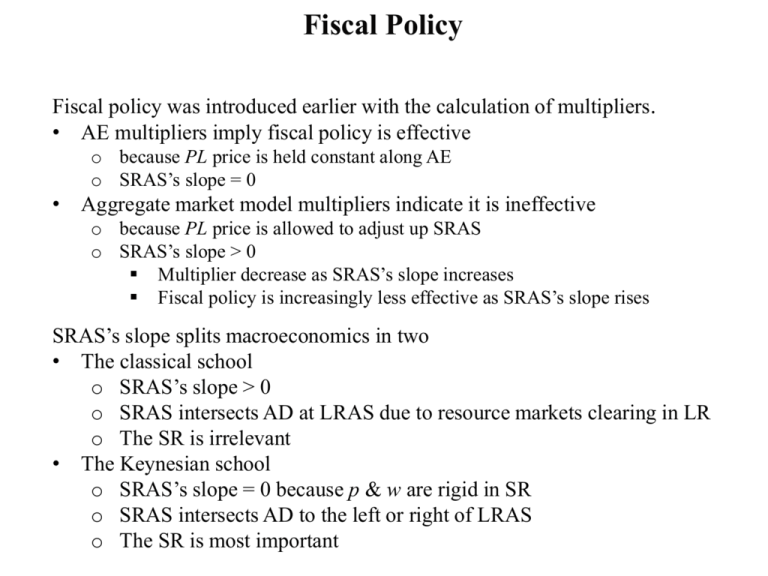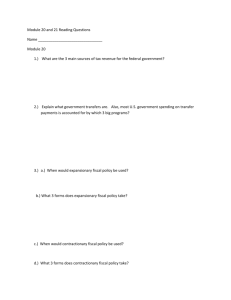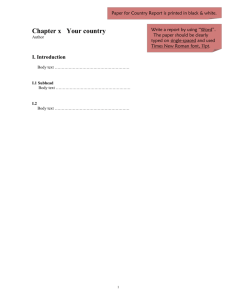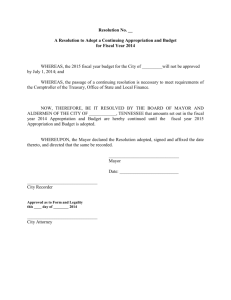Fiscal Policy
advertisement

Fiscal Policy
Fiscal policy was introduced earlier with the calculation of multipliers.
• AE multipliers imply fiscal policy is effective
o because PL price is held constant along AE
o SRAS’s slope = 0
• Aggregate market model multipliers indicate it is ineffective
o because PL price is allowed to adjust up SRAS
o SRAS’s slope > 0
Multiplier decrease as SRAS’s slope increases
Fiscal policy is increasingly less effective as SRAS’s slope rises
SRAS’s slope splits macroeconomics in two
• The classical school
o SRAS’s slope > 0
o SRAS intersects AD at LRAS due to resource markets clearing in LR
o The SR is irrelevant
• The Keynesian school
o SRAS’s slope = 0 because p & w are rigid in SR
o SRAS intersects AD to the left or right of LRAS
o The SR is most important
Fiscal Policy
The classical school
PL
The Keynesian school
PL
LRAS
115
LRAS
SRAS
115
15
Y
15
Y
Fiscal Policy
The classical school
PL
The Keynesian school
PL
LRAS
115
LRAS
SRAS
115
15
Y
14 15
Y
Fiscal Policy
The classical school
PL
The Keynesian school
PL
LRAS
115
LRAS
SRAS
115
15
Y
15 16
Y
Fiscal Policy
Government bonds
The federal budget is the primary tool of fiscal policy.
Discretionary changes in fiscal policy are deliberate changes in G designed to
affect the size of the budget deficit or surplus.
•
Budget surplus: Present when total government spending is less than total taxes
collected from businesses and consumers (G < T ).
Surpluses reduce the magnitude of the government’s outstanding debt.
•
Budget deficit: Present when total government spending exceeds total taxes
collected from businesses and consumers (G > T ).
Deficits are typically covered with borrowing.
•
Changes in the size of the federal deficit or surplus are often used to gauge
whether fiscal policy is stimulating or restraining AD, which arise from either:
A change in the state of the economy, or,
A change in discretionary fiscal policy.
Treasury borrows to cover deficits by auctioning bonds to banks, large firms,
foreign governments, central banks and international organizations.
Fiscal Policy
Government bonds
1926 China Treasury 5 Yuan Government Bond
Fiscal Policy
Government bonds
1949 Lebanon Treasury Bond
Fiscal Policy
Government bonds
1952 Former USSR victory treasury 10 rub bond
Fiscal Policy
Government bonds
1922 Weimar Republic German treasury bond
Fiscal Policy
Government bonds
USA Treasury Bonds
Fiscal Policy
Government bonds
USA Treasury Bonds
0
Mock Auction
FV P (1 i ) n
Fiscal Policy
The Keynesian view
Keynesian theory highlights the potential of fiscal policy as a tool capable of
reducing fluctuations in aggregate demand.
Following the Great Depression, Keynesians challenged the view that
governments should always balance their budget.
Rather than balancing their budget annually, Keynesians argue that countercyclical policy should be used to offset fluctuations in aggregate demand.
• Expansionary fiscal policy – used when the economy is weak
Recessionary gap exists if real GDP is less than potential output
Annual budget deficits can close this gap if the government
- Increases government purchases of goods & services
- Cuts taxes
• Restrictive fiscal policy – used when strong demand threatens to cause inflation
Inflationary gap exists if real GDP exceeds potential output
Annual budget surpluses can close this gap if the government
- reduces government spending
- raises taxes
Fiscal Policy
Expansionary
The classical school
PL
The Keynesian school
PL
LRAS
LRAS
118
115
SRAS
115
15
16
Y
14
PLAD [W Ye r mpc T G X I ] {mps mpm} Y
15
Y
Fiscal Policy
Expansionary
The classical school
PL
The Keynesian school
PL
LRAS
LRAS
121
118
115
SRAS
115
15
16
Y
14
PLAD [W Ye r mpc T G X I ] {mps mpm} Y
PLSRAS [ w p t b Yp ] b Y
15
Y
Fiscal Policy
Restrictive
The classical school
PL
The Keynesian school
PL
LRAS
115
LRAS
115
SRAS
113
14
15
Y
PLAD [W Ye r mpc T G X I ] {mps mpm} Y
15 16
Y
Fiscal Policy
Restrictive
The classical school
PL
The Keynesian school
PL
LRAS
115
LRAS
115
SRAS
113
111
14
15
Y
PLAD [W Ye r mpc T G X I ] {mps mpm} Y
PLSRAS [ w p t b Yp ] b Y
15 16
Y
Shortcomings of Fiscal Policy
Forecasting
In the 1970s,
• there were inflationary recessions
• there was stagflation
• wages and prices are not rigid as Keynesians believed
• SRAS slopes upward
Even if the Keynesian view that fiscal policy can close output gaps is valid,
doing so is futile because
• Predicting the size of the stimulus (DG or -DT) is difficult
• Forecasting is increasingly unreliable the further into the future predictions
are made
• Undershooting
• Overshooting
Shortcomings of Fiscal Policy
Forecasting
PL
LRAS
Undershooting a
recessionary gap
109
108
14
15
Y
PLAD [W Ye r mpc T G X I ] {mps mpm} Y
Shortcomings of Fiscal Policy
Forecasting
PL
Overshooting a
recessionary gap
LRAS
116
108
14
15
16
Y
PLAD [W Ye r mpc T G X I ] {mps mpm} Y
Shortcomings of Fiscal Policy
Forecasting
PL
Overshooting a
recessionary gap
LRAS
121
116
Can cause inflation
108
14
15
16
Y
PLAD [W Ye r mpc T G X I ] {mps mpm} Y
PLSRAS [ w p t b Yp ] b Y
Shortcomings of Fiscal Policy
Forecasting
PL
Undershooting an
inflationary gap
LRAS
116
115
15
16
Y
PLAD [W Ye r mpc T G X I ] {mps mpm} Y
Shortcomings of Fiscal Policy
Forecasting
PL
Overshooting an
inflationary gap
LRAS
116
108
14
15
16
Y
PLAD [W Ye r mpc T G X I ] {mps mpm} Y
Shortcomings of Fiscal Policy
Forecasting
PL
Overshooting an
inflationary gap
LRAS
Can cause
deflation
116
108
106
14
15
16
Y
PLAD [W Ye r mpc T G X I ] {mps mpm} Y
PLSRAS [ w p t b Yp ] b Y
Shortcomings of Fiscal Policy
Policy lag
Even if fiscal stimulus is predictable, there are delays in its implementation.
• It takes time to observe recessionary gaps because GDP & unemployment are not
observed in the present
• Months of observations are needed to make an accurate prognosis
• After a problem has been diagnosed, it takes time to decide the best course of action
o Congress must debate, compromise, amend, and vote
o Enacting it is challenging if the President’s party does not control Congress
o If the President’s party controls Congress, the Senate minority can stop
legislation with a 41 vote filibuster.
• After fiscal policy is signed into law, its effects are further delayed by
o revenue from new taxes collected a year or more after a change
o bureaucratic red tape that includes departments
‒ altering budgets
‒ adjusting spending habits
‒ screening grant or transfer payment applicants.
o Sometimes its implementation is purposely lagged by several years
‒ EGTRRA
‒ ACA
• The multiplier theory implies the economic benefits of fiscal stimulus take time to
unwind.
Fiscal policy can destabilize the economy
Shortcomings of Fiscal Policy
Policy lag
PL
LRAS
114
110
13
•
15
Y
Suppose there is a slump in private investment
PLAD [W Ye r mpc T G X I ] {mps mpm} Y
Shortcomings of Fiscal Policy
Policy lag
PL
LRAS
114
112
110
13 14 15
•
Y
While Congress is debating the type and size of fiscal policy, suppose private
investment bounces back a little
PLAD [W Ye r mpc T G X I ] {mps mpm} Y
Shortcomings of Fiscal Policy
Policy lag
PL
LRAS
114
112
110
13 14 15
•
Y
After each house of Congress has finalized their bills, suppose expectations of
the future improve as the two chambers reconcile their bills.
PLAD [W Ye r mpc T G X I ] {mps mpm} Y
Shortcomings of Fiscal Policy
Policy lag
PL
LRAS
114
114
112
110
13 14 15
•
17
Y
With the recessionary gap closed, the President signs the stimulus into law, and
the checks get mailed.
PLAD [W Ye r mpc T G X I ] {mps mpm} Y
Shortcomings of Fiscal Policy
Policy lag
PL
LRAS
116
114
112
110
13 14 15
•
17
Y
If the Fed does not dampen overstimulated AD with higher r, w & p get bid up
due to unemployment being below its natural rate.
PLAD [W Ye r mpc T G X I ] {mps mpm} Y
PLSRAS [ w p t b Yp ] b Y
Shortcomings of Fiscal Policy
Policy lag
PL
LRAS
118
116
114
112
110
13 14 15
•
17
Y
SRAS decreases until the induced inflationary gap is closed.
PLAD [W Ye r mpc T G X I ] {mps mpm} Y
PLSRAS [ w p t b Yp ] b Y
Shortcomings of Fiscal Policy
Crowding-out
PLAD W Ye r mpc T I G X mps mpm Y
Decline in
private investment
Increase in
budget deficit
Higher real
interest rates
Inflow of financial
capital from abroad
Appreciation
of the dollar
Decline in
net exports
•
Increased government borrowing to finance an enlarged budget deficit places
upward pressure on real interest rates, which retards private investment.
•
In an open economy, high interest rates attract foreign capital.
•
As foreigners buy more dollars to buy U.S. bonds and other financial assets,
the dollar appreciates.
•
The appreciation of the dollar causes net exports to fall.
•
Lower exports and private investment dampens the expansionary impact of a
budget deficit.
Shortcomings of Fiscal Policy
Rational expectations
PL
AD
SRAS
P1
Y1
New Classical: budget deficits merely substitute future taxes for current taxes.
•
•
If households do not anticipate higher future taxes, AD would increase.
However, households fully anticipate higher future taxes.
They save instead of spend, which means AD remains unchanged.
PLAD W Ye r mpc T I G X mps mpm Y
Shortcomings of Fiscal Policy
Rational expectations
Loanable Funds Market
S21
r
The Chicago School:
monetary policy should
grown MS at a slow, steady
rate because fiscal policy
exerts no effect on r, Y, or u
r1
D12
Q1
Q2
To finance a budget deficit, the government borrows in the loanable funds market.
• Under the new classical view, people save to pay expected higher future taxes.
• This permits the government to borrow the funds to finance the deficit without
pushing up the interest rate.
Shortcomings of Fiscal Policy
Vote buying
Political incentives also influence fiscal policy.
Legislators are delighted to spend money on programs that directly benefit their
own constituents but are reluctant to raise taxes because they impose a visible cost
on voters.
Politicians are half-Keynesians
Keynesians are proponents of budget deficits in recessionary gaps
- Democrats push for higher G to stimulate the economy
- Republicans propose cuts in T to stimulate the economy
- Both are Keynesians during recessions
Keynesians are proponents of budget surpluses in inflationary gaps.
- Democrats are against cuts in G
- Republicans are against higher T
- Neither are Keynesians during expansions
There is a political bias towards spending and budget deficits. Predictably, deficits
will be far more common than surpluses.
Shortcomings of Fiscal Policy
Automatic Stabilizers
Discretionary fiscal policy (even if it is effective) is unnecessary because there are
automatic fiscal stabilizers:
•
They increase the budget deficit (or reduce the surplus) during a recession
•
They increase the surplus (or reduce the deficit) during an economic boom.
•
The major advantage of automatic stabilizers is that they institute countercyclical fiscal policy without the delays associated with legislative action.
•
Examples include
Corporate profit tax
Unemployment compensation
SNAP
Progressive income taxation
Shortcomings of Fiscal Policy
Modern synthesis
A modern synthesis view about the efficacy of fiscal policy emerged from the
economic debates of the 1970s and 1980s.
•
Predicting discretionary fiscal policy’s size and properly timing it is
o difficult to achieve
o of crucial importance.
•
Automatic stabilizers reduce the fluctuation of aggregate demand and help to
direct the economy toward full-employment.
•
Fiscal policy is much less potent than the early Keynesian view implied.
Supply-side Fiscal Policy
From a supply-side viewpoint, the marginal tax rate is of crucial importance:
A reduction in marginal tax rates increases the reward derived from added work,
investment, saving, and other activities that become less heavily taxed.
High marginal tax rates will tend to retard total output because they
discourage work effort and reduce the productive efficiency of labor
adversely affect the rate of capital formation and the efficiency of its use
encourage individuals to substitute less desired tax-deductible goods for
more desired non-deductible goods.
Federal regulations, tax code, capital gains tax rates, double taxation on domestic
corporate profits, and triple taxation of overseas domestic profits can also be
considered supply-side taxes.
If supply-side policy is adopted to increase Yp by raising the LR production factors
(Z, K, R, L), the changes should be permanent.
Supply-side Fiscal Policy
People will not work and firms will not produce anything if the tax rate is 100%.
If no one
works
and nothing
is produce,
economy
generates no income.
People
pay
no income
taxes when
the taxthe
rate
is 0%. Hence,
Hence,
TaxRevenue
Revenue==00
Tax
2.5
Tax Revenue
2.0
(in trillions of $)
1.5
1.0
0.5
0
0
20
40
60
tax rate (percent)
80
100
Supply-side Fiscal Policy
If tax revenue is 0 when the tax rate is 0% or 100%, there is a tax rate where
tax revenue reaches a maximum value.
According to the diagram below, the optimal tax rate is 30%. This tax rate
generates $2.5 trillion in tax revenue.
2.5
Tax Revenue
2.0
(in trillions of $)
1.5
1.0
0.5
0
0
20
40
60
tax rate (percent)
80
100
Supply-side Fiscal Policy
tax revenue
revenue
is $1.7increases
trillion. to $2.5 trillion.
If the tax rate is cut
60%,
to tax
30%,
2.5
2.5
Tax Revenue
(in trillions of $)
2.0
1.7
1.5
1.0
0.5
0
0
20
30
40
60
60
tax rate (percent)
80
100
Supply-side Fiscal Policy
revenue
$2.5 trillion.
taxisrevenue
decreases to $1.7 trillion.
If the tax rate is raised
30%, tax
to 60%,
2.5
2.5
Tax Revenue
(in trillions of $)
2.0
1.7
1.5
1.0
0.5
0
0
20
30
40
60
60
tax rate (percent)
80
100
Supply-side Fiscal Policy
The Laffer Curve also suggests that when tax rates are “low,” a tax cut
lowers tax revenue.
2.5
2.5
Tax Revenue
2.0
(in trillions of $)
1.6
1.5
1.0
0.5
0
0
10
20
30
40
60
tax rate (percent)
80
100
Supply-side Fiscal Policy
Is t * = 50%
or is
t * < 25%
Source: quarterly data covering the 1954-2012 period from FRED and taxfoundation.org
Supply-side Fiscal Policy
Changes in marginal tax rates may exert an impact on AS because the changes will
influence the relative attractiveness of productive activity in comparison to leisure and
tax avoidance.
Impact of supply-side effects:
• Usually take place over a lengthy time period.
• There is some evidence that countries with high taxes grow more slowly—France
versus United Kingdom.
• There is evidence they are important for taxpayers facing extremely high tax rates
– say rates of 40 percent or above.
Supply-side Fiscal Policy
PL
LRAS
SRAS
PLAD W Ye r mpc T I G X mps mpm Y
P0
PLSRAS w p t b Yp b Y
AD
Y01
•
•
•
•
Permanent reductions supply-side taxes raise the incentive to earn and use resources
efficiently.
SRAS and LRAS increase, which is followed by an increase in AD (Say’s Law)
Over time permanent lower (competitive) taxes promote more rapid (sustainable)
growth.
If the government temporarily T or temporarily raised G, AD expands by
more than supply, resulting in inflation.
Supply-side Fiscal Policy
1986
Top rate cut from
50% to 30%
1990-93
Top rate raised from
30% to 39%
1997
Capital gains
tax rate cut
2003
Income, Estate, and Capital
Gains tax rate cuts
Austrian Economics and Fiscal Policy
The Austrian school of economics
• is an offshoot of classical economics
• advocates for a limited role for government in the economy
• is associated with classical (not present day political) liberalism.
• does not acknowledge the need for taxes and minimal intervention by the State
• generally does not don’t acknowledge macroeconomics existence
o The appropriate unit of analysis is at the individual level
o Austrians comment on macroeconomic issues
o fiscal and monetary stimulus should not be perused
FP an MP are not a cure
RP and MP treat symptoms
• Its solution for persistently high unemployment is the eliminate of policies that
make wages and prices rigid
o UI compensation
o the minimum wage
o pro-labor policy
o pro-business policy
o public assistance
o price controls in farm bills
o Interest rate targeting
Austrian Economics and Fiscal Policy
The Austrian school of economics
• Its solution for an inflationary gap is laissez faire, too.
o The Fed raises i to close the gap because firms would bid up w & p
o Innovation is inhibited by this
o In the absence of fiscal or monetary intervention, allowing low unemployment
to persist
‒ drives cost-saving innovation
‒ firms employ individuals who find creative ways to lower production costs
‒ Greater entrepreneurialism and technological adv. raise LRAS & SRAS
‒ u rises to just equal un as workers are replaced by labor-saving technologies
Austrian Economics and Fiscal Policy
LRAS
PL
Doing nothing
in the short run
118
115
12
15
Y
PLSRAS [ w p t b Yp ] b Y
Austrian Economics and Fiscal Policy
LRAS
PL
121
118
115
Doing nothing
in the short run
12
15
Y
PLSRAS [ w p t b Yp ] b Y
Austrian Economics and Fiscal Policy
LRAS
PL
Worrying about a
higher price level
118
115
12
15
Y
PLAD W Ye r mpc T I G X mps mpm Y
Austrian Economics and Fiscal Policy
LRAS
PL
Worrying about a
higher price level
118
115
105
11 12
15
Y
PLAD W Ye r mpc T I G X mps mpm Y
Austrian Economics and Fiscal Policy
LRAS
PL
Doing nothing
over the long run
115
12
15
Y
Fiscal Policy & Economic Performance
Fiscal Policy & Economic Performance
•
•
•
•
•
Fiscal policy lag implies past budget deficits should impact growth.
Correlations of growth & lags of the growth rate of budget balances is 0
Correlations of growth & per capita budget balance is 0
Strongest correlation: per capita budget balance is lagged eight quarters (See above).
Increasing the budget deficit by $2000 per citizen => 0.35-pct-pt increase in growth 2
years later
Fiscal Policy & Economic Performance
• Given the weak correlation between growth and lags of these budget measures, should
other policies perhaps be pursued?





